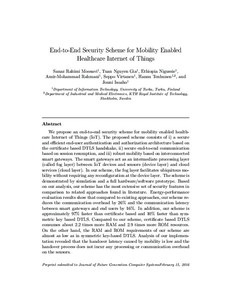End-to-end security scheme for mobility enabled healthcare Internet of Things
Nigussie E; Gia TN; Virtanen S; Isoaho J; Rahmani AM; Tenhunen H; Moosavi SR
End-to-end security scheme for mobility enabled healthcare Internet of Things
Nigussie E
Gia TN
Virtanen S
Isoaho J
Rahmani AM
Tenhunen H
Moosavi SR
ELSEVIER SCIENCE BV
Julkaisun pysyvä osoite on:
https://urn.fi/URN:NBN:fi-fe2021042715579
https://urn.fi/URN:NBN:fi-fe2021042715579
Tiivistelmä
We propose an end-to-end security scheme for mobility enabled healthcare Internet of Things (IoT). The proposed scheme consists of (i) a secure and efficient end-user authentication and authorization architecture based on the certificate based DTLS handshake, (ii) secure end-to-end communication based on session resumption, and (iii) robust mobility based on interconnected smart gateways. The smart gateways act as an intermediate processing layer (called fog layer) between IoT devices and sensors (device layer) and cloud services (cloud layer). In our scheme, the fog layer facilitates ubiquitous mobility without requiring any reconfiguration at the device layer. The scheme is demonstrated by simulation and a full hardware software prototype. Based on our analysis, our scheme has the most extensive set of security features in comparison to related approaches found in literature. Energy-performance evaluation results show that compared to existing approaches, our scheme reduces the communication overhead by 26% and the communication latency between smart gateways and end users by 16%. In addition, our scheme is approximately 97% faster than certificate based and 10% faster than symmetric key based DTLS. Compared to our scheme, certificate based DTLS consumes about 2.2 times more RAM and 2.9 times more ROM resources. On the other hand, the RAM and ROM requirements of our scheme are almost as low as in symmetric key-based DTLS. Analysis of our implementation revealed that the handover latency caused by mobility is low and the handover process does not incur any processing or communication overhead on the sensors. (C) 2016 Elsevier B.V. All rights reserved.
Kokoelmat
- Rinnakkaistallenteet [19207]
